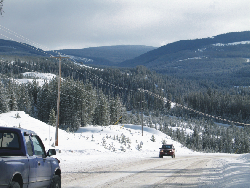Our Water Cycle
Dry to really, really dry
The Okanagan Basin is dry because it lies in the rain shadow of the Coast Mountains. This high mountain chain strips moisture from Pacific storms, leaving little for the basin. The farther south you go, the drier it gets. Cacti grow in the Okanagan Basin!
Upland snow catchers
Most water enters the Okanagan Basin as winter snow on the highlands. During the spring, snowmelt infiltrates into the ground or flows in streams to highland reservoirs and valley lakes.
The Okanagan loses most of what it gets
Only 15% of the rain and snow that falls in the basin flows to lakes and remains there. The rest leaves the basin through transpiration from forests and crops, and evaporation from lakes.

White Lake, west of Okanagan Falls, completely evaporates in summer, leaving behind a dry lake floor of white mineral salts. (R.J.W. Turner, GSC 2006-150)

The Okanagan River at Penticton. This is the main river of the Okanagan Valley. Not very big!
(R.J.W. Turner, GSC 2006-151)



